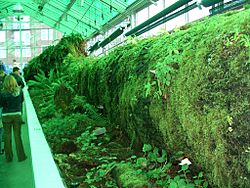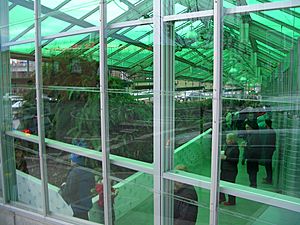Neukom Vivarium facts for kids
Quick facts for kids Neukom Vivarium |
|
|---|---|

Neukom Vivarium in 2007
|
|
| Artist | Mark Dion |
| Year | 2006 |
| Dimensions | 24 m (80 ft) |
| Location | Olympic Sculpture Park, Seattle, Washington, United States |
| 47°36′57″N 122°21′16″W / 47.61585°N 122.35431°W | |
| Owner | Seattle Art Museum |
Neukom Vivarium is a special art project created in 2006 by American artist Mark Dion. You can find it at the Olympic Sculpture Park in Seattle, Washington, United States. This artwork is a mix of different materials and ideas, known as a mixed media installation.
The main part of the artwork is a huge Western hemlock tree, about 60 feet (18 meters) long. This tree fell naturally near Seattle in 1996. Now, it acts as a "nurse log" inside a large greenhouse that is 80 feet (24 meters) long. A nurse log is a fallen tree that helps new life grow, like a natural nursery.
The Seattle Art Museum, which runs the park, explains that this tree is part of an "art system." This system includes tiny living things like bacteria, fungi, insects, lichen, and different plants that live on and around the log. Visitors can use magnifying glasses to look closely at these creatures. There are also special tiles that act as field guides, showing what you might find.
This amazing artwork was given as a gift by Bill and Sally Neukom, American Express Company, the Seattle Garden Club, the Mark Torrance Foundation, and the Committee of 33. They donated it to celebrate the Seattle Art Museum's 75th birthday. Neukom Vivarium was the very first permanent public artwork by Mark Dion in the United States. The greenhouse structure was designed by Owen Richards Architects.
Contents
What is the Neukom Vivarium?
Neukom Vivarium is a unique mixed media art piece by American artist Mark Dion. It's located in Seattle, Washington, at the Olympic Sculpture Park. The idea for this artwork was approved in 2004, and it was finished in 2006.
The Seattle Art Museum describes Neukom Vivarium as a blend of art, building design, environmental learning, and gardening. It connects art with science in a very special way.
The Nurse Log and Its Home
The main feature is a 60-foot (18-meter) long nurse log. This log used to be part of a natural forest ecosystem. Now, it lives inside an 80-foot (24-meter) long greenhouse, becoming part of an "art system."
Inside the greenhouse, there's a special cabinet designed by Mark Dion. This cabinet holds magnifying glasses for visitors. These tools let you get a super close look at the log and all the tiny life forms living on it. You'll also find blue and white tiles that work as field guides. They show pictures of the bacteria, fungi, insects, lichen, and plants you might spot on the log.

Choosing the Perfect Tree
Mark Dion originally wanted to use either a Douglas fir or a Western hemlock tree for his artwork. He liked the Douglas fir for its "mythic presence," meaning it felt very grand and important. He chose the Western hemlock because it was charming and is also the official state tree of Washington.
The hemlock tree used for Neukom Vivarium fell naturally on February 8, 1996. It was in a protected area near Seattle with very old trees, called an old-growth forest. Because of where it fell, the natural process of the tree breaking down (called biodegradation) slowed down. Mark Dion said the tree "had just fallen into [their] lap." It was perfect because it was easy to get, had a unique look, and was the right size.
The Artist's Message
Mark Dion explained his thoughts about the exhibit:
"I think that one of the important things about this work is that it's really not an intensely positive, back-to-nature kind of experience. In some ways, this project is an abomination. We're taking a tree that is an ecosystem—a dead tree, but a living system—and we are re-contextualizing it and taking it to another site. We're putting it in a sort of Sleeping Beauty coffin, a greenhouse we're building around it. And we're pumping it up with a life support system—an incredibly complex system of air, humidity, water, and soil enhancement—to keep it going. All those things are substituting what nature does, emphasizing how, once that's gone, it's incredibly difficult, expensive, and technological to approximate that system—to take this tree and to build the next generation of forests on it. So, this piece is in some way perverse. It shows that, despite all of our technology and money, when we destroy a natural system, it's virtually impossible to get it back. In a sense, we're building a failure."
Dion's quote means that while the artwork is amazing, it also shows how hard it is to recreate nature once it's gone. He calls it a "Sleeping Beauty coffin" because the greenhouse keeps the tree alive with lots of technology. This shows that even with all our money and science, it's almost impossible to fully bring back a natural system once it's destroyed. It's a powerful message about protecting our environment.
Images for kids


